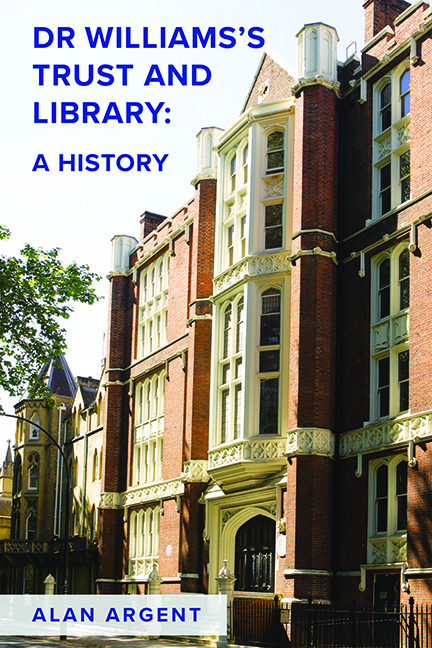Book contents
- Frontmatter
- Dedication
- Contents
- List of Illustrations
- Foreword
- Preface
- Abbreviations
- Notes on Dates, Money, Welsh Place Names and Publications
- Prologue
- 1 Dr Williams and His Will
- 2 Benjamin Sheppard, Receiver 1721–31: Faith, Fitness, and Diligence
- 3 Constructing the Library Building 1725–30: A Proper Plan
- 4 Francis Barkstead, Receiver 1731–47: Piety and Charity
- 5 John Cooper, Receiver 1748–62: Liberty and Liberal Dissent
- 6 Richard Jupp junior, Receiver 1762–95: A Very Respectable Body
- 7 Richard Webb Jupp, Receiver 1795–1850, and David Davison, Receiver 1850–7: Fashionable Sympathies Amid Increasing Light
- 8 Walter D. Jeremy, Receiver 1857–93: The Scrupulous Observer
- 9 Francis H. Jones, Secretary and Librarian 1886–1914: Introducing Order
- 10 Robert Travers Herford, Secretary and Librarian 1914–25: Application and Imagination
- 11 Stephen Kay Jones, Librarian 1925–46, and Joseph Worthington, Secretary 1925–44: A New Age with Old Strains
- 12 Roger Thomas, Secretary 1944–66 and Librarian 1946–66: Trusted Innovator
- 13 Kenneth Twinn, Secretary and Librarian 1966–76: Modest Dependability
- 14 John Creasey, Librarian, and James McClelland, Secretary, 1977–98: Mixed Blessings
- 15 David Wykes, Director 1998–2021: Past, Present, and Future
- 16 Dr Williams’s Trust: An Assessment
- Appendix 1 Trustees in 1723
- Appendix 2 Lists from Short Account (with later additions)
- Bibliography
- Index
9 - Francis H. Jones, Secretary and Librarian 1886–1914: Introducing Order
Published online by Cambridge University Press: 26 May 2022
- Frontmatter
- Dedication
- Contents
- List of Illustrations
- Foreword
- Preface
- Abbreviations
- Notes on Dates, Money, Welsh Place Names and Publications
- Prologue
- 1 Dr Williams and His Will
- 2 Benjamin Sheppard, Receiver 1721–31: Faith, Fitness, and Diligence
- 3 Constructing the Library Building 1725–30: A Proper Plan
- 4 Francis Barkstead, Receiver 1731–47: Piety and Charity
- 5 John Cooper, Receiver 1748–62: Liberty and Liberal Dissent
- 6 Richard Jupp junior, Receiver 1762–95: A Very Respectable Body
- 7 Richard Webb Jupp, Receiver 1795–1850, and David Davison, Receiver 1850–7: Fashionable Sympathies Amid Increasing Light
- 8 Walter D. Jeremy, Receiver 1857–93: The Scrupulous Observer
- 9 Francis H. Jones, Secretary and Librarian 1886–1914: Introducing Order
- 10 Robert Travers Herford, Secretary and Librarian 1914–25: Application and Imagination
- 11 Stephen Kay Jones, Librarian 1925–46, and Joseph Worthington, Secretary 1925–44: A New Age with Old Strains
- 12 Roger Thomas, Secretary 1944–66 and Librarian 1946–66: Trusted Innovator
- 13 Kenneth Twinn, Secretary and Librarian 1966–76: Modest Dependability
- 14 John Creasey, Librarian, and James McClelland, Secretary, 1977–98: Mixed Blessings
- 15 David Wykes, Director 1998–2021: Past, Present, and Future
- 16 Dr Williams’s Trust: An Assessment
- Appendix 1 Trustees in 1723
- Appendix 2 Lists from Short Account (with later additions)
- Bibliography
- Index
Summary
Although DWL was experiencing change, its claim to be a public library was still questionable. That a reader needed an introduction, though a mere formality, presented an obstacle to newcomers, cautious in the capital and unfamiliar with Unitarians and with dissent in general. A new librarian reordered DWL's life. Would the move to Gordon Square, and the ending of the receiver's post, concentrate resources on the library?
Francis Henry Jones
Jones succeeded Hunter as DWT secretary and librarian in 1886, after the latter's retirement in the previous year. According to Jeremy in 1885, DWL contained some ‘35,000 volumes of printed books, 500 volumes of manuscripts’, and numerous portraits, chiefly of nonconformists. Describing it as ‘primarily a Theological Library’, he allowed that it also contained works ‘ancillary’ to theological and cognate studies. The library was free, open Monday to Friday and Saturday mornings. He added that ‘A large number of gentlemen’, whose names may be seen at DWL, ‘are privileged to introduce Readers’. Evidently readers still needed an introduction, though a less formal arrangement than previously, to consult the books, which now ‘Under certain restrictions’ were lent.
This was DWL on Jones's appointment. Among his innovations, he improved the efficiency of recording and checking the issue of books, and initiated an index of readers. He encouraged the appointment of an assistant librarian (the first in DWL's history) and developed a postal service, so that in 1896 DWL sent out 1,705 parcels, as distinct from 583 in 1886. In 1914, DWL sent 6,896 parcels of books. Although Jones was accused of making DWL stricter and less personal, readers found the service more reliable. Yet, like Hunter, he oversaw DWL's move from one site to another, in his case from Grafton Street, with little room for growth and books crammed tightly on the shelves, to University Hall, Gordon Square, which itself underwent alterations in 1915. In 1890 DWT acquired premises that accommodated for the first time both the receiver and the library and that allowed for expansion. Nonetheless moving DWL three times in thirty years was demanding.
DWT's last quarterly meeting in Grafton Street was held in March 1890 and their first in Gordon Square in June. The former dining room became DWL's lecture hall and the college library its reading room.
- Type
- Chapter
- Information
- Dr Williams's Trust and Library , pp. 172 - 192Publisher: Boydell & BrewerPrint publication year: 2022



